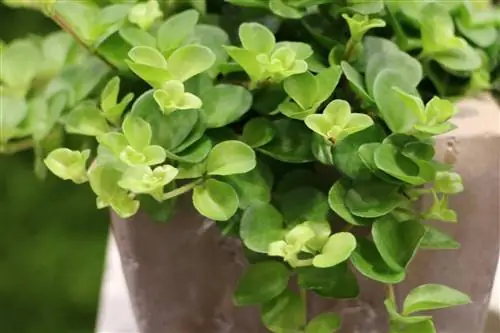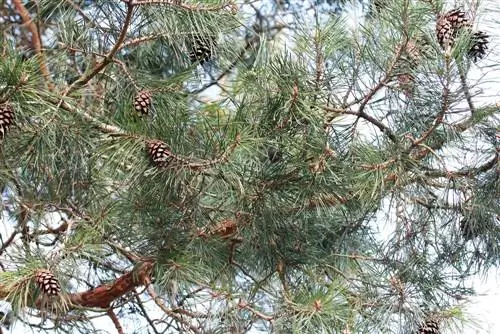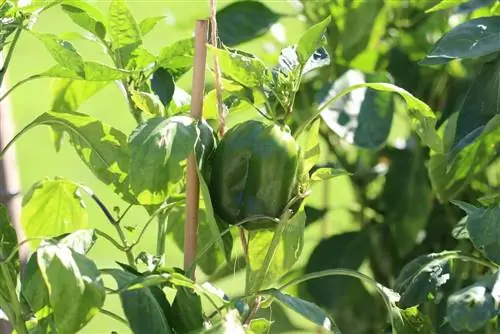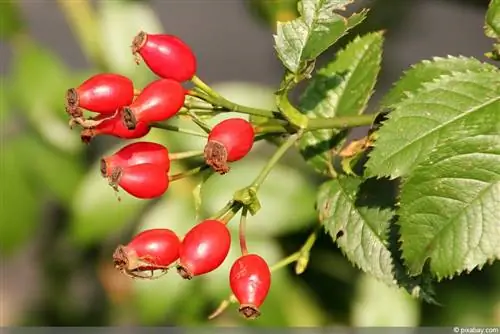- Author admin [email protected].
- Public 2023-12-17 03:39.
- Last modified 2025-01-24 12:45.
Peperomia Rotundifolia - a particularly beautiful form of the dwarf pepper - is undemanding and therefore also suitable for beginners in plant care. However, the culture also requires a little knowledge so that the plant thrives over the long term. Because this dwarf pepper is difficult to forgive mistakes in care and rescue is rarely possible. However, if you stick to the following care tips, you will have a lot of fun with the little plant.
Location
The location of the Peperomia Rotundifolia should be warm, bright and moist. However, blazing midday sun is poorly tolerated. It is therefore good to have a window sill in the bathroom or kitchen facing east or west. It can also be a south-facing window if the dwarf pepper is protected from direct midday sun. If you prefer to admire the Peperomia Rotundifolia in the living room or home office, you can also place it in these rather dry rooms. However, this increases the maintenance effort somewhat. Ideal temperatures for the dwarf pepper are between 18 and 23 °C. In summer, the plant can easily be left outdoors.
Substrate
A mixture of peat and standard soil has proven to be a good substrate for the dwarf pepper. However, this is not particularly environmentally friendly. A suitable alternative to this is a mixture of potting soil, a little sand and tropical soil, such as that offered for aquariums. The main things are that the soil is not prone to waterlogging and instead is well drained. A drainage layer at the bottom of the planter is therefore mandatory. Coarse gravel, pottery shards or coconut fiber are ideal. These are placed as the first layer in the flower pot and the appropriate soil is filled on top.
Pouring
The Peperomia Rotundifolia likes it moist but not wet. Watering and spraying should be carried out accordingly. The soil must always be kept slightly moist for the dwarf pepper, but should be allowed to dry slightly between waterings. The substrate should never dry out completely, but waterlogging should also be avoided. The latter is very poorly tolerated and quickly leads to rot. For watering the Peperomia Rotundifolia, soft water is used that is ideally at room temperature. Collected rainwater is the best solution. Stale or filtered tap water also serves the purpose. This should also be the choice for spraying, which is carried out once or several times a week depending on the location. The drier and warmer the location, the more frequently you should spray.
Fertilize
From March to September, the dwarf pepper is fertilized once a month. A liquid complete fertilizer for green plants is suitable, which is added to the irrigation water in half or quarter doses. Alternatively, a long-term fertilizer in stick form can also be used. Here too, a smaller dosage should be used. Fertilization does not need to be suspended between September and March. However, during this phase the interval between doses is increased to eight weeks.
Intersection
Peperomia Rotundifolia does not need to be pruned, but it tolerates slight corrections without any problems. It is important that the cut surfaces can dry quickly afterwards, so spraying should be avoided for at least a day after this measure.
Propagation
The propagation of the dwarf pepper is extremely easy and is carried out using cuttings. Both head cuttings and individual leaves can be used. The procedure was as follows:
- In spring, individual leaves with a stem that is at least 2 cm long or head cuttings with at least three leaves are cut for propagation.
- The cut surfaces should dry first so that no rot develops in the open and therefore sensitive areas.
- Prepared in this way, the cuttings are placed in potting soil consisting of one part peat and sand or in potting soil loosened with sand.
- The substrate should be kept very moist during the first few weeks and should not dry out at all between waterings. In addition, there must be temperatures of at least 20 °C and high humidity. The young plant cannot initially tolerate direct sun.
- If new leaves appear, roots have developed. The small dwarf pepper can then be transplanted into the substrate described above.
- Watering can also be reduced slowly and gradually from the time the leaves grow back.
In order to create optimal conditions for the propagation of Peperomia Rotundifolia, the cultivation container should be placed in a greenhouse or covered with transparent film.
Tip:
Rooting aid, for example special powder from specialist retailers, accelerates the growth of the dwarf pepper.
Wintering
The dwarf pepper is uncomplicated when overwintering. This means that it does not need a separate winter quarters, but can remain in place. The intervals between fertilizer applications are increased to two months and watering is also reduced slightly. However, the substrate must not dry out.
Especially in dry and warm heated air, it is also beneficial to spray some lime-free water on the plant every day. If Peperomia Rotundifolia is in the bathroom or kitchen anyway, this is not absolutely necessary. As an alternative to warm overwintering, the dwarf pepper can also be kept a little cooler during its resting phase. However, the temperature should not fall below 15°C. The cooler Peperomia Rotundifolia is during the winter, the less the plant should be watered. Fertilization can then also be temporarily stopped. In spring the temperature and care are gradually increased again.
Repotting
The Peperomia Rotundifolia should be repotted if necessary, but at the latest after two years. The procedure is as follows:
- In spring the root ball is completely freed from the old substrate. Due to the already high humidity, it is beneficial to rinse the soil with water. The water should be lukewarm or at least room temperature.
- A slightly larger pot is filled with a drainage layer and some substrate.
- The plant is inserted carefully and the pot is completely filled with soil.
- The dwarf pepper is then watered and fertilized directly.
It is particularly important that the pot is only enlarged slightly, if necessary. Planters that are too large quickly contain too much water for the root ball, which in turn promotes root rot.
Typical care errors, pests and diseases
The dwarf pepper is not susceptible to pests and diseases. Even if the houseplant is left outdoors in summer, the risk of infestation or infection is very low. However, a common care mistake often leads to the Peperomia Rotundifolia dying very quickly, seemingly for no reason. We're talking about overwatering and the resulting root rot. If the soil is wet, there is water in the planter or there is no drainage, rot is not far away. Even if the cut surfaces of cuttings are not dried before they are put into the ground, mold often forms on them.
Slightly drying between waterings, a small pot with drainage and well-drained soil can prevent the outbreak of root rot. You should also make sure that the soil is not dripping wet after watering. In addition to waterlogging, water can also lead to another problem. If it contains too much lime, the tubules in the dwarf pepper become clogged. The plant gradually changes color and dies. Therefore, only soft water should be used.
Conclusion of the editors
The dwarf pepper Peperomia Rotundifolia is an attractive houseplant that is surprisingly robust and resilient when cared for properly. If it is given enough water and placed in a favorable location, it will even show flowers in the warm season. Even without this, the plant is an eye-catcher thanks to its strong green.
What you should know about the dwarf pepper in brief
Peperomia rotundifolia is a dwarf pepper with small, strong green leaves. It is an easy-care and undemanding plant that even produces small flower umbels.
Location
- Peperomia rotundifolia needs a bright location. Morning and evening sun are well tolerated.
- However, you should protect the plant from direct midday sun.
- This dwarf pepper can also overwinter in a warm living room. He likes it warm all year round.
- High humidity is an advantage.
Planting substrate
- Commercial potting soil is suitable as a planting substrate. You can mix this with a little sand to make it well-drained.
- Soil with fibrous peat also works well.
- Drainage at the bottom of the pot is recommended so that excess water can drain away easily.
- The plant pot should not be too large, otherwise the weak root system will become waterlogged too easily.
Pouring
- The plant substrate should be kept evenly moist. Standing moisture is not tolerated.
- That's why it's important to check after watering that there is no excess water in the planter or saucer.
- This needs to be poured out. Constantly wet feet quickly lead to rot.
- It is ideal if the substrate surface can dry a little between waterings. However, the plant ball must not dry out completely.
- It is best to use lime-free or low-lime water for watering and also for spraying.
- The watering water should not be too cold, room temperature is ideal.
Fertilize
- You fertilize in the main growth phase, i.e. from spring to autumn.
- Fertilization is carried out every four weeks with liquid fertilizer, but only at half the concentration.
- Fertilizer sticks can also be used this way. The rest of the year you fertilize about every eight weeks.
Wintering
- Peperomia rotundifolia likes to overwinter warmly, but can also tolerate slightly lower temperatures.
- But these should not fall below 15 °C. Little is watered in winter, but the plant ball must never dry out completely.
- The cooler the temperatures are during wintering, the less watering needs to be done.
- Dry room air is not tolerated very well. That's why you should spray the plant every now and then.
Propagate
- Peperomia rotundifolia is most easily propagated via cuttings. Both head and leaf cuttings are possible.
- Even at normal room temperatures, they are easy to propagate from cuttings.
- You separate one or more shoots from the mother plant.
- You can place these shoots in a glass of water so that they root or you can plant them directly.
- Cuttings that are planted immediately should have about three leaves.
- The planting depth is around 3 to 5 cm. To ensure that the new plant looks compact and grows, always plant several cuttings together.
- Normal potting soil is suitable as a planting substrate. It's a good idea to mix in sand.
- The substrate is kept wet during the first few weeks.
- After about four weeks, even moisture is sufficient.
- It is a good idea to put a plastic bag over the planter. This increases the humidity.
- But it must be ventilated regularly, preferably daily, so that the soil does not become moldy.
- The container with the cuttings should be placed in a bright place. Direct sun must be avoided at all costs.
- The temperatures should not fall below 18 to 20 °C.
Propagation through leaf cuttings also works quite well. However, rooting takes longer. Young, well-developed leaves with a stem about 2 cm long are used. The stem is inserted up to the width of the leaf into the slightly moistened plant substrate, which should consist of equal parts sand and peat. The soil is only moistened again when the surface has dried thoroughly. It is beneficial to use rooting powder.






